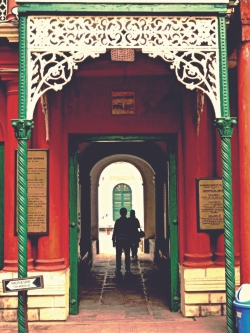| Home - Back Issues - The Team - Contact Us |
 |
| Volume 12 |Issue 08| February 22, 2013 | |
|
|
Heritage Jorasanko Thakur Bari Sarara Ishraar Hasan
Bengal is a land of thinkers, philosophers and artists. My family and I had recently returned from a wonderful trip to that part of Bengal, where the very growth of Bengali literature had been witnessed. And that part of Bengal is Kolkata. This was my first ever visit to Kolkata. Before going there, I had already developed a picture inside my head about how Kolkata would look and better yet, even smell like. You know, from word of mouth; dirty, stinky and noisy. I couldn't help but to NOT agree with it. The well-built British colonial buildings, vintage yellow ambassador taxis and the sound of melodious Bengali accents, really got me caught up with the curiosity of discovering more of Kolkata. We had visited some famous places in the city but out of all the places, I had personally adored Jorasanko Thakur Bari. It is also commonly known as the House of Thakurs. It was the ancestral home of the Tagore family which now serves as The Tagore Museum for Kolkata. This was the house where Nobel Laureate and famous poet, Rabindranath Tagore, had spent almost half of his life. It is also the very place where he had breathed his first and also his very last.
The Jorasanko Thakur Bari is located in the Rabindra Bharati University campus at 6/4 Dwarakanath, Tagore Lane, North Kolkata. It was built in the 18th century by Rabindranath Tagore's grandfather, Prince Dwarakanath Tagore. According to the staff of the museum, the mansion had earned its name from the Shiva temples, which are addressed as “Jora Shankar”, or “Twin Shankar” which exists in the vicinity of the Thakur Bari. When I set my eyes on the house, the first thing I noticed was that it was a magnificently huge mansion. The walls were painted burnt orange and the windows bottle green. The whole mansion was surrounded by a garden of luscious green grass and tall sheltering trees. The mansion itself had a big clean courtyard in its centre. Before even entering the museum, I could feel the luxury that Rabindranath was surrounded by during his years spent in the house. I was very impressed by the way this three-century-year-old mansion had been maintained. It looks as if someone still lived there. The tickets were only ten Rupees for adults and five Rupees for students. As we were waiting in line at the ticket booth, I noticed a woman exiting the museum. She had asked the man selling the tickets, “How much did you say the tickets were again?” The man had replied bluntly, “Ten Rupees.” The woman had then said with a surprised look, “For such an amazing heritage like this? It should've been more!” Not until I had entered the mansion had I realised what she meant.
The house was breathtakingly huge and beautiful. Unfortunately, cameras weren't allowed inside. The whole house was floored with smooth cool cement. I knew it was cool because we had to take our shoes off before entering. Each and every piece of furniture in the house was extravagant and reflected classical Bengal. The house was seeped in the history of the Tagore family. We had tiptoed our way from one room into the other. Each room had a different story to tell. Some rooms had Rabindranath Tagore's photographs, some had his tapes and records and others had his books, manuscripts and many other items. There are three main galleries in the museum. The first gallery, called the “Vichitra Bhavana”, showcases the life and memorable activities of the poet. It covers his visits to Burma and Moscow and also his meetings with Albert Einstein, Helen Keller and some Arabic Bedouins. The second gallery, called the “Maharishi Bhavana”, portrays the distinguished members of his family through photographs and family trees including of Dwarakanath Tagore (grandfather of Rabindranath), Maharishi Debendranath Tagore (father of Rabindranath), Abanindranath Tagore (brother of Rabindranath) and Rabindranath's other brothers and sisters. The gallery consists of the poet's bedroom, the room where he died and also a family maternity room where many of the Tagore family members, including Rabindranath, were born. The third gallery, called the “Ram Bhavana”, is the depiction of the Bengal Renaissance and the contributions of the pioneers of the Tagore family. According to the guides of the museum, the mansion contained more than 700 photographs and about 750 paintings on display. The whole museum experience is exhilarating. The house is clean and well maintained. It takes quite some time if one wants to see everything the museum has to offer. During our whole time venturing the museum, my parents had hummed along to the harmonious sounds of Tagore's songs that were being played through speakers which were set up around the whole mansion. I was amazed by the way the mansion had been arranged to establish the emotion of Tagore's life into the thoughts of anyone who visited the museum. According to the staff of the museum, the best time to visit the museum is on Rabindranath Tagore's birthday, also referred to as Panchise Baishakh, where cultural events and programmes are organised in the museum by Rabindra Bharati University. The university also organises the poet's death anniversary, Baishe Shravana, and also a festival of arts called Aban Mela all in the museum. The Jorasanko Thakur Bari was a home to eminent personalities who had played a major role in spreading Bengali art and literature and even modern education. My family and I had a splendid time visiting the museum and I, personally, had learned so much. The history of Bengal is incomplete without Tagore and that is why without a visit to this magnificent heritage site will make anyone's trip to Kolkata incomplete.
Copyright
(R) thedailystar.net 2013 |


